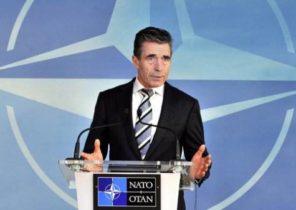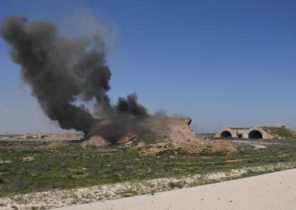
The crisis in the Persian Gulf, it seemed, reached such an extent that some observers began to talk about the possibility of military intervention against Qatar, Saudi Arabia and the United Arab Emirates after the failure of the Qatari authorities to meet their demands. At the same time, some experts believe that these requirements were formulated in such a way that to fulfil them was simply impossible, which in turn would make the inevitable military intervention.
“Arabs kill Arabs, destroy their cities and shed rivers of Arab blood” — this is the grim picture of Arab life for several decades, the causes of which are buried in the ground and hidden from our eyes. That is why we need to take a little dive into the depths of history to understand what is happening to us today. After all, the present is born in the womb of the past, and history teacher for those who want to know the truth. In this report, in the midst of discussions about possible military intervention in Qatar, we remember five of the largest armed clashes between the Arab countries that occurred in the modern era.
The war in Yemen in 1962
The war in Yemen, which the Yemenis called “the Revolution of 26 September,” began in the 60-ies of the last century and lasted until 1967 until the defeat of Egypt, or the so-called “NaX”, 1967 (the six day war 1967 — approx. ed.).
The war began when supporters of the Republican regime surrounded the Palace of the Imam al-Badr, resulting in Mutawakkilite Kingdom fell, and the Imam fled to Saudi Arabia. However, the United Kingdom, Saudi Arabia and Jordan continued to maintain its supporters until 1970, while Gamal Abdel Nasser made in this war on the Republican side. Thereby he hoped to earn points against Saudi Arabia, which, in his opinion, were behind the collapse of the United Republic created by Egypt and Syria. In addition, his goal was to spread socialism in the Arab region and create progibatsya modes in accordance with the ideas of pan-Arabism, which he promoted.
Yemen was the monarchical government, and had the official name of Yemen Mutawakkilite Kingdom. The monarchy was a British colony, and when some emirs have expressed a desire to join the United Arab Republic, which was formed between Egypt and Syria in 1958, the king of Yemen had opposed and expelled them from the country. After in 1961 the United Arab Republic collapsed, Gamal Abdel Nasser began a fierce war against the king of Yemen in retaliation, Saudi Arabia, which, he believed, were responsible for the failure of the United States with Syria. In addition, Nasser supported the Marshal Abdullah Al-Solely that a military coup against the king of Yemen.
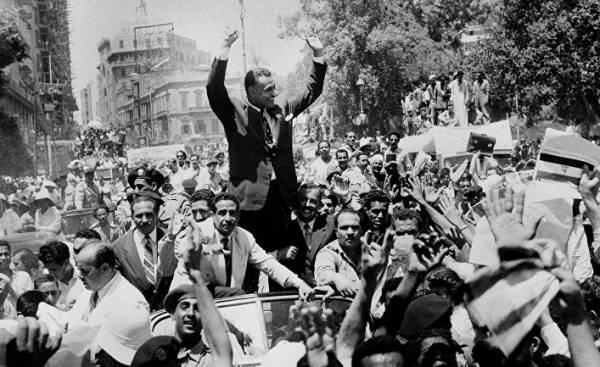 © AP Photo, Egyptian President Gamal Abdel Nasser in Cairo. 1956
© AP Photo, Egyptian President Gamal Abdel Nasser in Cairo. 1956
The war began in 1962 and lasted until 1970, has lasted eight years, though major combat operations were discontinued in 1968 after the defeat of Egypt in the war a year earlier (an event known as naksa — the defeat). The king of Yemen left the country and found refuge in Saudi Arabia, where he led military action against Egypt, with the joint support of countries like Saudi Arabia, Jordan and the UK.
Egypt won a military victory in Yemen and contributed to the development of this state. However, if we talk about the price of victory was very high — in the Yemen war, Egypt suffered the greatest losses in modern history of the country. The Egyptian army was completely exhausted, were killed and nearly 26 thousand soldiers, with the consequence that Yemen became known as Vietnam. With regard to the financial cost of the Egyptian war, they amounted to 40 million Egyptian pounds.
“Sand war” between Morocco and Algeria in 1963
“The Moroccans we are humiliated,” — said Algerian President Ahmed Ben Bella in a speech to the citizens of the country, speaking about the ambitions of Morocco in the Algerian desert, and perhaps it is this famous phrase entrenched in the minds of those who witnessed the “sand war” broke out between Morocco and Algeria in October 1963. It happened after one year and three months from the time Algeria gained independence. The conflict was preceded by weeks of border clashes that eventually led to armed conflict between the armies of the two countries on the outskirts of Tindouf and Khasi-Beida. Then the confrontation spread to the Moroccan Figuig and ended only after the intervention of the League of Arab States and the Organization of African unity (OAU). So, in 1964, the parties ceased fire, however, the war left behind the tensions between Morocco and Algeria, which is observed at present.
Talking about the details of this war, it should be noted that the king of Morocco Hassan II visited Algeria after independence, calling on President Ben Bella to comply with the agreement on the settlement of border disputes, which was signed with the Algerian provisional government informed. After that, between the two countries erupted information warfare: Algeria considered Morocco’s expanding the zone of influence in the region, while the Moroccan authorities believed that such accusations is the President of Egypt Gamal Abdel Nasser, who supported the opposition movement against the Arab monarchies, apart from these modes of reaction. Moroccan party “Istiqlal” (Independence) rejected the accusations of the Algerian regime, Egypt and Algeria launched an information campaign against the Kingdom. Meanwhile, in 1963, published a map of the “Great Morocco”, which included a third of Algeria, which was the cause of the outbreak of the present war between the two States. Algerian forces attacked the district of Khasi-Beida, killing ten Moroccan soldiers. In response, the government of Morocco sent to Algeria by an official delegation in order to put an end to such attacks, but did not achieve a result. In the end, the negotiations took place, and the country was on the brink of war.
A September 1970. “Black September”
“Black September” — the so-called tragic events, which occurred in September 1970. This month, the Jordanian king Hussein Ben Talal took action against what he described as an attempt by Palestinian organizations to overthrow the monarchy in Jordan. The origins of this conflict date back to the end of the battle of Karama, which occurred between Jordan and Israel in 1968. Then, Israel attacked the Jordanian village of Karama in response to Palestinian attacks perpetrated from the territory of Jordan. The battle ended with the defeat of Israel, but these events have caused more than five hundred violent clashes between Palestinian groups and the security forces of Jordan in the period from mid-1968 to late 1969.
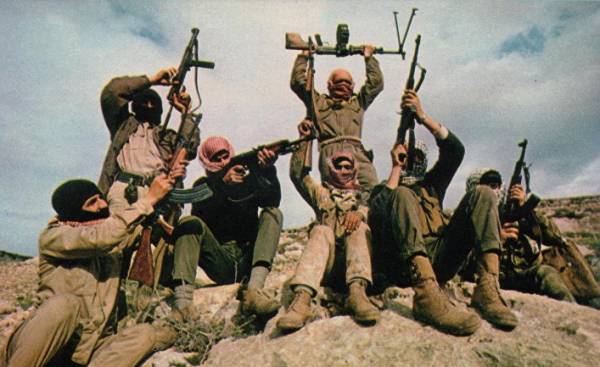 © Wikipedia, Thomas R. Koepel group “popular front for the liberation of Palestine”
© Wikipedia, Thomas R. Koepel group “popular front for the liberation of Palestine”
9 June 1970 was made an unsuccessful assassination attempt on king Hussein during the passage of his motorcade in the heart of Amman. A sniper, hiding in the minaret of the mosque, “al-Husseini”, opened fire on the car of the king, one of the bullets hit the back of Zaid al-Rafai, who was trying to protect the monarch. This incident resulted in clashes between the country’s security forces and the Palestinian organizations, which lasted from February to June 1970. Killing about a thousand people. King Hussein understood that it is necessary to strike a crushing blow on the Palestinian factions within the country.
This time, however, Syria decided to intervene to protect Palestinian militants. With this objective in Jordan was sent three tank brigades, one brigade “commando”, a team of Palestinian militants and more than 200 T-55 tanks. As a result, the war dragged on for a month, killing tens of thousands of people, mostly Palestinians, and Palestinian fighters were expelled from Jordan.
Egyptian-Libyan war of 1977
Egyptian-Libyan war short border conflict between Libya and Egypt, which occurred in July 1977, after tensions in the relations between the two countries in April and may of the same year. So, in July, Colonel Gaddafi ordered about 225 thousands of Egyptians working in Libya to leave the country before March 1, otherwise they will be subjected to arrest. Soon after the shootout between border forces of the two countries, and then ground and air strikes. Already on 24 July, an agreement was reached on a ceasefire under the mediation of Algerian President Houari Boumediene.
The spark for the outbreak of hostilities was the so-called “March on Cairo”. So, with the filing of their own government, which opposed the diplomatic rapprochement between Egypt and Israel, 20 July 1977, thousands of Libyans headed to the Egyptian border. Libyan leader Muammar Gaddafi has called for the destruction of boundaries that prevent the revival of the Arab peoples and their unification, and, in particular, advocated the unity of the two States, following the approach of Gamal Abdel Nasser, which, according to Gaddafi, was rejected by the new President of Egypt Anwar Sadat. Libyan leader believed that the Egyptian people will also speak against their President, as observed popular discontent in connection with Sadat’s intention to establish relations with Israel. And when the Egyptian border guards stopped the protesters, Libya’s artillery units opened fire on the Egyptian border crossings.
© Personal archive of Muammar Gaddafi/Michael Christopher BrownСемейный archive Gaddafi
On 24 July under the mediation of Algeria and the Palestinian leader Yasser Arafat head of the Palestine liberation Organization, agreement was reached on a cease-fire. Fighting stopped on 25 July 1977, but despite this, the differences between them are preserved. In August 1977 there was an exchange of prisoners of war that have strained relations between Egypt and Libya.
As for the other Arab countries, they took opposing positions on the conflict. So, the conservative regimes that support Egypt, saw action in Libya, the violation of Egyptian sovereignty, while Arab nationalist regimes acted on the side of Libya, having criticized the Egyptian-Israeli rapprochement. Later it will lead to the fact that most Arab States boycott of the Egyptian regime, freezing the last membership in the League of Arab States. This will happen after the visit of Anwar Sadat to Israel and the signing between the parties of the peace agreement in camp David.
After the death of Sadat in 1981 and the appointment of Hosni Mubarak to the post of President was created the Committee for Libyan-Egyptian relations. It was headed by Ahmad Qaddaf hell-Give, has been appointed as coordinator of relations between Egypt and Libya.
The second war in the Persian Gulf
A war waged by an international coalition led by the United States, began after the invasion of the Iraqi regime (headed by President Saddam Hussein) of Kuwait in 1990. Then the Kuwaiti authorities have been accused of stealing Iraqi oil and conspiring against the ruling regime. The war lasted 40 days and ended with the ousting of Iraqi forces from Kuwait, the reduction of military and economic power of Iraq, as well as the introduction of the blockade against the country, which caused a dramatic deterioration of the humanitarian situation in the Iraqi state.
© RIA Novosti | go to fotoracconti Saddam Hussein
The roots of this conflict date back to the period of receipt of Iraq’s independence from the United Kingdom in 1932, while Kuwait became independent from the British in 1961. A week after the proclamation of independence of Kuwait, the head of Iraq’s Abdel Karim Qassem declared the claims on Kuwaiti territory, caused an international crisis. The Arab League intervened by sending Arab forces consisting of armed forces of Saudi Arabia, the United Arab Republic and Sudan to Kuwait. Abdel Karim Qassem argued his claims that Kuwait was part of Iraq and was taken away from the last in the era of British colonialism. 4 Nov 1963, Iraq recognized the independence and sovereignty of Kuwait, within the established boundaries, and during the Iran-Iraq war, Kuwait and Saudi Arabia provided the Iraqi regime of economic support. In particular, the volume of Kuwaiti assistance to Iraq during this war has reached almost $ 14 billion.
Baghdad had hoped to pay these debts by raising oil prices by reducing its production by OPEC, but prices remained low, forcing Saddam Hussein accusing Kuwait of deliberately increasing the volume of oil production with the aim to apply the Iraq damage. Events began to assume a dangerous character: Saddam Hussein began to accuse Kuwait that he illegally carried out work on the extraction of oil in the Iraqi part of the joint field Rumaila (kuvasta part of the field has the name there came). So, the President of Iraq Saddam Hussein said that the aim of the Iran-Iraq war, which lasted about eight years, was protecting the Eastern borders of the Arab world, and therefore Kuwait and Saudi Arabia are obliged to negotiate with Iraq about the payment of debts or even forgive them.
2 August 1990 major units of the Iraqi army crossed the Iraqi-kuvasto the border. On the territory of Kuwait was Iraqi armored vehicles and tanks, they established control over key centers of the country, after Saddam Hussein declared Kuwait the nineteenth province of Iraq. The Emir of Kuwait Sheikh al-Sabah fled to Saudi capital, Riyadh, where he headed the Kuwaiti government-in-exile, while Iraq continued to control Kuwait for seven months.
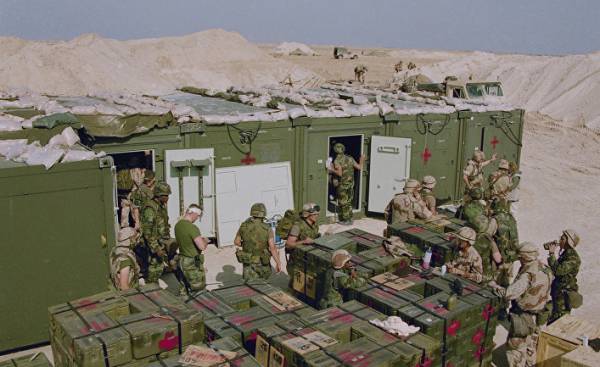 © AP Photo, Mcamacho operation “desert Storm”, the installation of a field hospital
© AP Photo, Mcamacho operation “desert Storm”, the installation of a field hospital
The United States led a coalition of 38 countries to liberate Kuwait. The coalition’s operation was called “desert Storm” began at dawn on 16 January 1991, after Iraq had not fulfilled the condition of the UN Security Council on the withdrawal of its troops from Kuwait during the day. The coalition forces headed by America began intensive aerial bombardment of Iraq. All were deposited 109867 air strikes during the 43 days, that is, 2555 impact per day, during which it was used 60624 tons of bombs.
Iraq responded to these bombings by the fact that on January 17 launched seven Scud missiles at Israel in an attempt to involve it in war. In addition, a number of rockets were launched on the cities of Dhahran and Riyadh in Saudi Arabia. Among the most prominent goals of the Iraqi missiles on the territory of Saudi Arabia, became an American military area in Dhahran. The result of the Iraqi missile attack killed 28 American soldiers. Other Arab countries also took part in the war against Iraq, while countries such as Algeria and Morocco took a neutral position. There were those who declared their support for Iraq, for example, Jordan.
Among the countries that sent troops to liberate Kuwait, have been Egypt, Saudi Arabia and other Persian Gulf States. As for the statistics of the losses incurred by the Iraqi side, they are different, but the average death toll is between 70 to 100 thousand people. In addition, 30 of thousands of Iraqi soldiers were captured, was destroyed four thousand tanks, 3100 guns, 1856 vehicles for transportation of soldiers and about 240 aircraft. This war is the most famous and fierce inter-Arab war of the modern era.
The possibility of new inter-Arab war in the Persian Gulf
Question about military intervention in Qatar or any other country is associated with the right to intervene in the Affairs of other States. Whether we are talking about intervention in form or content, and its rights are neither Saudi Arabia nor the United Arab Emirates. These two countries are the same as in Qatar, and they have no specific prescription for such intervention, as happened, for example, in Yemen, where the initiator of the hostilities was the so-called legitimate government, while the goal of the military intervention in Qatar is recognized as a change in the existing mode, so it will not have legitimacy at the international level.
Saudi Arabia and the UAE can intervene in the situation in Qatar only after obtaining the appropriate resolution from the UN, but it is almost impossible to do, considering how many of Qatar’s allies, and all the nuances of regional and international competition.
As a consequence, the question of military intervention in Qatar is not on the agenda of the observers. As mentioned above in the context of the current international reality, it is not possible from the point of view of international law because there is no corresponding request from the legitimate government, like the UN resolution allowing such intervention. Another important factor is the extensive network of allied relations, which has the Qatar. We should not forget about the Turkish military base, which will be five thousand troops, as well as the U.S. call for dialogue to settle the crisis.
The intervention, which hinted Saudi Arabia and the UAE, aims to overthrow the current government in Qatar and replace it with another regime, the foreign policy which would serve the interests of these two States, however, this can only be attained through an internal coup, not outside interference. However, this is unlikely, as such a revolution is a potential threat to the current monarchical regimes in the Persian Gulf. If the coup happens in one of these countries, then the rest will also be threatened.
The possibility of military intervention to overthrow the current regime were a real threat for Qatar in the first days of the crisis, especially given the uncertainty in the position of the United States in that period. This is evidenced by the decision of the Qatari leadership to give rise to a Turkish military presence in the country, which, on the one hand, can help reflect attempts to destabilize the country from within. On the other hand, it also made for the aggressors the political consequences.
Qatar is not the only country threatened by a possible coup in the context of the current crisis in the Persian Gulf. So, Saudi relations with the UAE are characterized by a large number of potentially explosive problems. Among them, the intervention of the Emirates in Yemen, which undermines the interests of Saudi Arabia, raising the level of cooperation between the UAE and Iran. All this, given the conflicts between the Emiratis and the Saudis in the past, can cause a ruthless war in the Persian Gulf, but between Saudi Arabia and the UAE.


